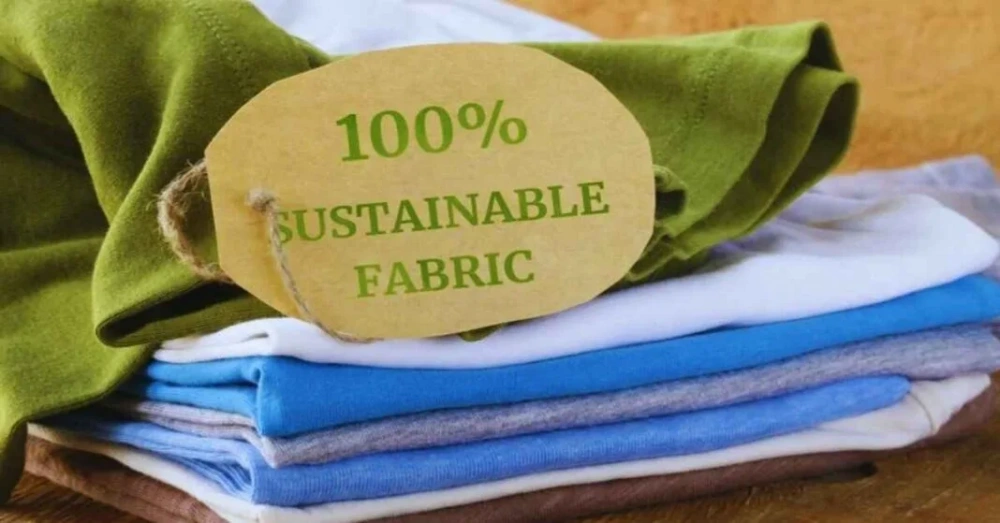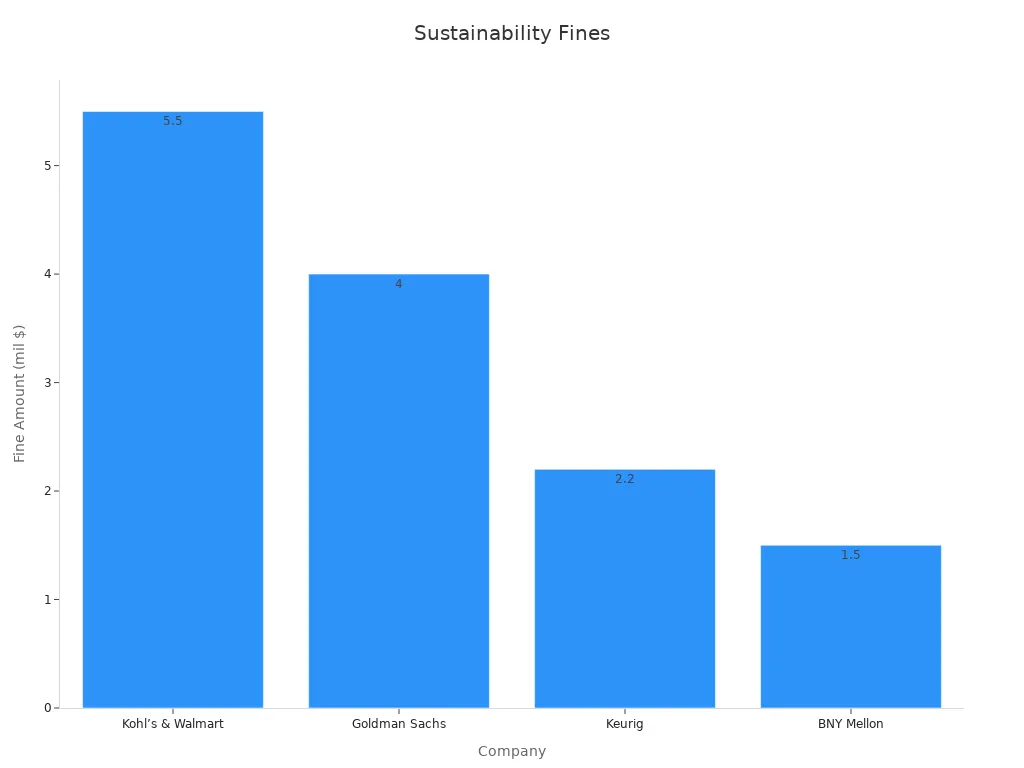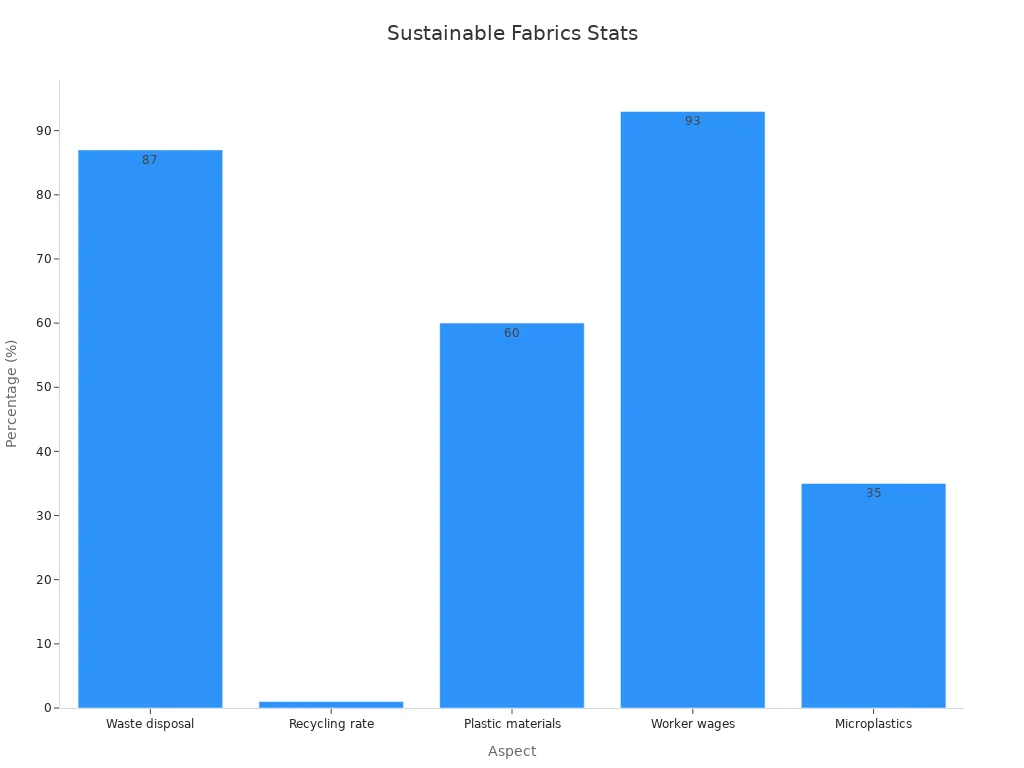You might wonder, what are sustainable fabrics? These are fabrics made with methods and materials that protect the planet and support fair working conditions. In 2025, choosing sustainable fabrics matters more than ever. The fashion industry creates nearly 10% of global greenhouse gas emissions and 20% of industrial water pollution.
Synthetic fabrics release tons of microplastics into oceans, and about 87% of all fabrics end up in landfills or are burned. When you pick sustainable fabrics, you join a growing movement for cleaner water, less waste, and better choices in sustainable fashion.
The fashion industry generates 92 million tons of textile waste each year.
Fabric dyeing creates 20% of global wastewater.
Nearly half of shoppers now choose sustainable products and will pay more for them.
Key Takeaways
Sustainable fabrics use renewable or recycled materials and reduce pollution, water use, and waste compared to traditional fabrics.
Choosing sustainable fabrics helps protect the environment by lowering carbon emissions, saving water, and reducing microplastic pollution in oceans.
Sustainable fabrics support fair working conditions and ethical production, improving the lives of workers in the fashion industry.
Look for trusted certifications like GOTS and OEKO-TEX to ensure fabrics are truly sustainable and avoid misleading greenwashing claims.
Buying sustainable fabrics benefits the planet, people, and brands by promoting cleaner production, social responsibility, and growing market demand.
What Are Sustainable Fabrics?
Definition
So, what are sustainable fabrics? You can think of them as materials made with the planet and people in mind. These fabrics use fewer resources, create less pollution, and often come from renewable or recycled sources. When you choose sustainable clothing materials, you help reduce the impact of fashion on the environment.
Sustainable textiles focus on the entire life cycle—from how the fibers are grown or made, to how the fabric is produced, used, and even what happens when you’re done with it.
Let’s look at how different fibers stack up when it comes to energy use and emissions:
Fiber Type | Energy Consumption (MJ/kg) | Total CO2 Emissions (ton/ton fiber) |
|---|---|---|
Flax (natural) | 10 | N/A |
Cotton (natural) | 55 | 2.35 – 5.90 |
Wool (natural) | 63 | N/A |
Viscose (synthetic) | 100 | N/A |
Polypropylene (synthetic) | 115 | N/A |
Polyester (synthetic) | 125 | 9.52 |
Acrylic (synthetic) | 175 | N/A |
Nylon (synthetic) | 250 | N/A |
You can see that natural fibers like flax and cotton use much less energy than synthetic ones like polyester or nylon. The textile industry uses about 93 cubic meters of water every year—enough to fill 37 million Olympic swimming pools!
Making just one cotton T-shirt can use up to 2,720 liters of water. That’s about what you drink in three years. These numbers show why sustainable fashion materials matter so much.
Did you know? The textile industry ranks fourth in raw material use and fifth in greenhouse gas emissions worldwide. Most research and recycling efforts focus on cotton and polyester, but there’s a big need to expand these efforts to other fibres like wool, silk, and linen.
Key Features
When you look for sustainable fabrics, you’ll notice some key features that set them apart from traditional options. These features help protect the environment and make your clothes more comfortable and durable.
Here’s what you can expect from sustainable fabrics:
They use renewable or recycled fibers, like organic cotton, hemp, or recycled polyester.
They require less water, energy, and chemicals during production.
They support circular economy strategies, such as recycling and reusing old textiles.
They often come from ethical sources, supporting fair wages and safe working conditions.
They break down more easily at the end of their life, reducing landfill waste.
Recent studies have tested sustainable fabrics made from textile waste and found some impressive benefits. Check out these verified features:
Verified Feature | Measurement / Range | Implication / Verified Benefit |
|---|---|---|
Thermal Conductivity | < 0.05 – 0.06 W/(m·K) | Improved thermal insulation and energy efficiency |
Sound Absorption Coefficient | > 0.6 (for frequencies > 500 Hz, 2.5 cm thick panels) | Enhanced sound insulation |
Dynamic Stiffness | 7 to 13 MN/m³ | Effective damping properties for sound insulation |
Loss Factor | 0.22 to 0.27 | Indicates material’s energy dissipation capacity |
Air Flow Resistivity | < 100 kN·s/m⁴ | Supports diffuse sound absorption |
You’ll also notice a lot of innovation happening in the world of sustainable fabrics. Here are some trends you might spot:
More brands use recycled polyester from PET bottles and regenerated fibers like lyocell.
Companies develop bio-based leather and plant-based wool alternatives.
Biodegradable sequins made from cellulose are popping up in new designs.
Eco-friendly jacket fillings now come from bulrush seedheads.
Organic fabrics lead the market, showing that shoppers care about health and wellness.
Governments and brands set new sustainability goals, and technology helps create next-generation green materials.
Sustainable fabrics aren’t just a trend—they’re a smart choice for you and the planet. When you pick these materials, you support a cleaner, fairer, and more innovative fashion industry.
Why Sustainable Fabrics Matter
Environmental Impact
You see the effects of unsustainable fabrics everywhere in 2025. The world faces record fiber production, stricter regulations, and growing textile waste. When you choose sustainable fabrics, you help tackle these urgent challenges. Here’s a quick look at the biggest environmental issues:
Environmental Challenge | Description |
|---|---|
Textile Waste Volume | 92 million tons produced each year; only 20% are recycled or reused; most end up in landfills or get burned |
Carbon Emissions | Fashion industry creates 10% of global emissions—about 10 billion tons of CO₂ |
Water Usage | Making 1 kg of cotton fiber uses 1,931 liters of irrigated water and 6,003 liters of rainwater |
Water Pollution | Textile factories cause 20% of global wastewater pollution; toxic dyes pollute rivers |
Microplastics | 200,000-500,000 tons enter oceans yearly from synthetic fabrics; these take centuries to break down |
Market Growth | Fast fashion doubles production, leading to more waste and pollution |
Sustainable fabrics offer a solution. They use less water, and fewer chemicals, and create less waste. Life Cycle Assessment (LCA) shows that lower-impact fabrics reduce carbon footprints, water use, and energy needs.
You make a difference by choosing eco-friendly and lower-impact fabrics. Wearing your clothes longer also cuts down on waste and pollution. Sustainable textiles help you support a cleaner planet and healthier communities.
Tip: The more times you wear a piece of sustainable clothing, the more you reduce its environmental impact!
Social Responsibility
Sustainable fabrics do more than protect the environment. They also support people. When you pick sustainable options, you encourage ethical production practices and better working conditions.
Many companies now focus on social responsibility, using digital tools to track their supply chains and make sure workers get fair treatment.
Studies show that sustainable fabric supply chains, especially in places with strong labor laws, have fewer social risks. You help reduce labor abuses and improve lives by supporting sustainable and ethical brands. Choosing lower-impact fabrics means you care about both the planet and the people who make your clothes.
Sustainable fabrics matter in 2025 because they address real problems—pollution, waste, and unfair labor. Your choices push the fashion industry toward more environmentally friendly and ethical production practices. Every time you choose sustainability, you help build a better future.
Types of Sustainable Fabrics

Natural Fibers
You probably see natural fibers everywhere in sustainable fashion materials. These plant-based fabrics come from eco-friendly sources like organic cotton, hemp, linen, and bamboo.
They stand out because they are renewable, biodegradable, and usually have a lower environmental impact than synthetic options. Take a look at how natural fibers compare to synthetic ones:
Property/Aspect | Natural Fibers | Synthetic Fibers |
|---|---|---|
Renewability | Renewable | Non-renewable |
Biodegradability | Biodegradable | Non-biodegradable |
Density | Lower (1.2–1.6 g/cm³) | Higher (approx. 2.4 g/cm³) |
Energy Consumption | Lower | Higher |
Environmental Impact | Eco-friendly disposal | Non-eco-friendly disposal |
You get more than just a soft feel with these fabrics. You support a cleaner planet. Sometimes, natural fibers need special treatments to improve their strength and moisture resistance, but they remain a top choice for eco-textiles and sustainable cotton lovers.
Recycled Materials
Recycled materials give old fabrics new life. You help reduce waste and save resources when you choose recycled polyester, recycled cotton, or even upcycled denim. Here are some quick facts:
In 2018, only 14.7% of textile waste in the U.S. was recycled, but that still saved 2.5 million tons from landfills.
Making one cotton shirt uses about 2,700 liters of water, so recycling saves a lot of water.
Programs like Patagonia’s Worn Wear show how recycling and reselling clothes can cut landfill waste and encourage sustainable habits.
You can find recycled materials in many sustainable fabrics. They help you close the loop and support a circular economy.
Innovative Options
You see a wave of innovation in sustainable fabrics. Tencel lyocell leads the way as a plant-based, eco-friendly fabric made from wood pulp. Tencel lyocell uses a closed-loop process, so almost all water and solvents get reused.
You also find fabrics made from pineapple leaves, orange peels, and even mushroom roots. These new materials push the boundaries of what sustainable fashion can be.
Friendtex stands out as a manufacturer that can produce a wide range of sustainable fabrics, from organic cotton and hemp to Tencel lyocell and recycled polyester. If you want to build your own sustainable fabrics list, look for options like linen, bamboo, and other plant-based choices.
These eco-friendly fabrics come from eco-friendly sources and help you make a real difference.
Tip: When you pick sustainable cotton, tencel, lyocell, or other plant-based fabrics, you support a future where fashion and the planet thrive together.
Identifying Sustainable Fabrics

Certifications
You want to make sure your clothes are truly sustainable, not just labeled that way. Certifications help you spot the real thing. These labels show that a fabric meets strict environmental and social standards. When you see these on a tag, you know the brand has taken extra steps for the planet and for people.
Here are some of the most trusted certifications you’ll find on sustainable fabrics:
Global Organic Textile Standard (GOTS): This label means the fabric contains at least 70% organic fibers. It also bans toxic chemicals and requires fair wages and safe working conditions.
OEKO-TEX Standard 100: This certification tests for over 100 harmful substances. It helps you avoid clothes that could harm your skin or the environment.
Fair Trade: This label supports fair wages and ethical working conditions for workers.
BLUESIGN: This one checks the entire supply chain for environmental safety.
SA8000: This social certification focuses on fair working conditions.
You can check the table below to see how these certifications work:
Certification | Verified Criteria | Sustainability Focus |
|---|---|---|
GOTS | Minimum 70% organic fiber; bans toxic chemicals; enforces fair wages and safety | Organic fiber use, environmental protection, social responsibility |
OEKO-TEX 100 | Tests for 100+ harmful substances; ensure chemical and skin safety | Chemical safety, human health, environmental protection |
Certifications like these turn vague promises into facts. They help you trust that your sustainable choices really make a difference.
Avoiding Greenwashing
Not every product with a green label is truly sustainable. Some companies use words like “eco-friendly” or “natural” without proof. This is called greenwashing. You can avoid it by looking for real certifications and checking if brands share details about their materials and processes.
Here’s how you can spot misleading claims:
Watch out for vague terms like “green,” “conscious,” or “planet-friendly” with no clear explanation.
Look for third-party certifications, not just brand-made logos.
Check if the company explains how their fabric is sustainable—do they mention water use, chemicals, or recycling?
See if the brand is transparent about where and how they make their products.
Recent years have seen big fines for companies making false sustainability claims. Take a look at this chart showing some well-known cases:

Tip: When in doubt, ask questions or do a quick search for the certification. Real sustainable brands are happy to share details.
By learning to spot real certifications and avoid greenwashing, you make smarter, more sustainable choices every time you shop.
Benefits of Sustainable Choices
For the Planet
When you choose sustainable fabrics, you help protect the earth. These fabrics use fewer resources and create less pollution. You cut down on waste and save water every time you pick sustainable clothes. Here are some facts that show the difference you make:
Aspect | Statistic / Fact | Implication / Benefit of Sustainable Fabrics |
|---|---|---|
Annual garment production | 80-100 billion garments produced yearly | Reducing overproduction through sustainable fabrics lowers waste |
Waste disposal | 87% of clothing ends in landfills or incineration | Sustainable fabrics reduce landfill and incineration burden |
Recycling rate | Only 1% of clothes recycled into new garments | Sustainable fabrics promote circularity and recycling |
Resource consumption | 98 million tonnes of non-renewable resources used annually | Sustainable fabrics use renewable or recycled materials |
Plastic-based materials | 60% of clothing materials derived from fossil fuel-based plastics | Sustainable fabrics reduce reliance on fossil fuel plastics |
Water usage | 93 billion cubic meters of water used yearly in textile production | Sustainable fabrics reduce water consumption |
Water pollution | Textile dyeing is the 2nd largest water polluter globally | Sustainable fabrics reduce toxic dye pollution |
Microplastic pollution | Synthetic fibers contribute 35% of microplastics in oceans | Sustainable fabrics reduce microplastic ocean contamination |
You can see that sustainable fabrics help lower pollution, save water, and keep plastic out of the ocean. Every small choice adds up to a big impact.
For People
Sustainable fabrics do more than help the planet. They also support people. When you buy sustainable clothes, you support fair wages and better working conditions. Most fashion companies do not pay living wages, but sustainable sourcing changes that. You help workers and their families live better lives.
93% of fashion companies do not pay living wages. Sustainable fabrics support social equity.
33% of consumers prefer brands that act responsibly.
93% of people worldwide believe companies should help the environment.
You make a difference when you choose sustainable fabrics. You show that you care about the people who make your clothes.
For Brands
Sustainable choices help brands grow and build trust. More shoppers want sustainable clothing and fabrics. In fact, 66% of consumers will pay more for sustainable brands. Companies that focus on sustainability see lower risks and stronger reputations.

The market for sustainable fabrics is growing fast, with a projected 12.5% yearly increase through 2032. Brands that use sustainable fabrics can cut costs by about 15% and attract loyal customers. Investors also prefer companies with strong sustainability records.
Tip: If you want your brand to stand out, work with experienced manufacturers like Friendtex. They can help you create high-quality, sustainable fabrics and reach your sustainability goals.
Conclusion
You play a key role in shaping a better future with sustainable fabrics. The fashion industry still creates about 10% of global emissions, and brands face pressure to change.
When you choose sustainable fabrics, you help reduce waste, save water, and support fair labor. Every purchase sends a message. Let’s keep pushing for more transparency and real progress in a sustainable fashion. Your choices matter—start making a difference today!
FAQ
What makes a fabric truly sustainable?
You want to look for fabrics made from renewable or recycled materials. Check for trusted certifications like GOTS or OEKO-TEX. These show the fabric meets strict environmental and ethical standards.
How can you tell if a brand is greenwashing?
Watch for vague claims like “eco-friendly” without proof. Real sustainable brands share details about their materials and processes. Look for third-party certifications and transparent information.
Tip: Always check for official labels and ask questions if you’re unsure!
Are sustainable fabrics more expensive?
Sometimes you might pay a bit more for sustainable fabrics. You get better quality, longer-lasting clothes, and support fair wages. Many shoppers feel the extra cost is worth it.
Can you find stylish options with sustainable fabrics?
Absolutely! Many brands now offer trendy, comfortable, and stylish clothes made from sustainable fabrics. You don’t have to sacrifice style for sustainability.
Organic cotton tees
Tencel dresses
Recycled polyester jackets
You have lots of choices!


